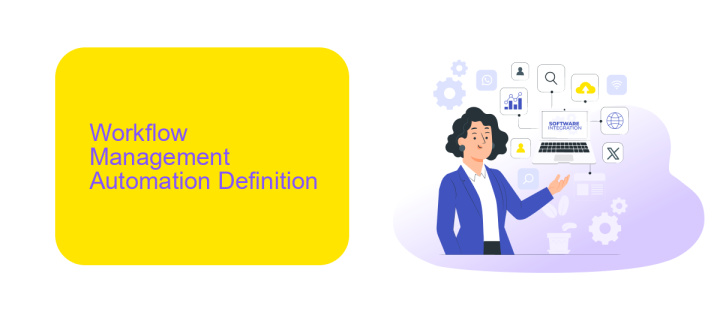Workflow Management Automation
In today's fast-paced business environment, workflow management automation has become essential for enhancing efficiency and productivity. By automating routine tasks and streamlining processes, organizations can reduce errors, save time, and allocate resources more effectively. This article explores the benefits, key features, and implementation strategies of workflow management automation, demonstrating how it can transform the way businesses operate.
Introduction
Workflow management automation has become a pivotal aspect of modern business operations, streamlining processes and enhancing efficiency. By automating repetitive tasks, organizations can focus on more strategic initiatives, driving growth and innovation.
- Reduces manual errors
- Increases productivity
- Enhances collaboration
- Facilitates real-time monitoring
One of the key components of successful workflow automation is seamless integration between various tools and platforms. Services like ApiX-Drive enable businesses to effortlessly connect their applications, ensuring smooth data transfer and communication. This not only saves time but also ensures that all systems are up-to-date and synchronized, leading to more informed decision-making and improved overall performance.
Workflow Management Automation Definition

Workflow management automation refers to the use of technology to streamline and optimize the various processes involved in managing workflows. This includes automating repetitive tasks, reducing human error, and increasing overall efficiency. By implementing workflow automation tools, organizations can ensure that tasks are completed consistently and on time, allowing employees to focus on more strategic activities. These tools often come with features like task scheduling, progress tracking, and real-time notifications, which help in maintaining a smooth workflow.
One of the key aspects of workflow management automation is the integration of various software and services to create a seamless operational environment. Services like ApiX-Drive facilitate this by offering easy-to-use integration solutions that connect different applications and automate data transfer between them. This not only saves time but also ensures data accuracy and consistency across platforms. By leveraging such services, businesses can achieve a higher level of automation, making their workflow management more efficient and effective.
Benefits of Workflow Management Automation

Workflow management automation offers numerous advantages for businesses looking to optimize their operations and enhance productivity. By automating repetitive tasks and streamlining processes, companies can achieve significant improvements in efficiency and accuracy.
- Increased Efficiency: Automation reduces the time spent on manual tasks, allowing employees to focus on more strategic activities.
- Enhanced Accuracy: Automated workflows minimize human errors, ensuring more reliable and consistent outcomes.
- Cost Savings: By reducing the need for manual labor, businesses can lower operational costs and allocate resources more effectively.
- Improved Compliance: Automation helps maintain compliance with industry regulations by ensuring that all processes are documented and followed correctly.
- Better Collaboration: Tools like ApiX-Drive facilitate seamless integration between various software systems, enabling better communication and collaboration among teams.
In conclusion, adopting workflow management automation can lead to substantial benefits for organizations. By leveraging advanced tools and technologies, companies can enhance their operational efficiency, reduce costs, and improve overall performance. Embracing automation is a strategic move that can drive long-term success and competitiveness in today's fast-paced business environment.
Types of Workflow Management Automation

Workflow management automation streamlines complex business processes, enhancing efficiency and reducing manual effort. There are several types of workflow management automation that organizations can implement to optimize their operations.
One common type is rule-based automation, which uses predefined rules to trigger actions. This type is ideal for repetitive tasks that follow a specific pattern. Another type is integration-driven automation, which connects different software systems to work seamlessly together. Tools like ApiX-Drive facilitate this by allowing easy setup of integrations between various platforms.
- Rule-based automation
- Integration-driven automation
- Robotic process automation (RPA)
- Artificial intelligence (AI) automation
Robotic process automation (RPA) uses software robots to mimic human actions, handling tasks such as data entry and transaction processing. AI automation leverages machine learning and natural language processing to make intelligent decisions and improve over time. By understanding these types of workflow management automation, organizations can choose the most suitable methods to enhance their productivity and operational efficiency.
Considerations for Workflow Management Automation Implementation
When implementing workflow management automation, it's crucial to first assess your organization's specific needs and objectives. Identify the processes that will benefit most from automation and evaluate the potential return on investment. This requires a thorough analysis of current workflows, pinpointing bottlenecks and areas for improvement. Additionally, consider the scalability of the chosen automation tools to ensure they can grow with your business and adapt to future changes.
Integration is another key consideration. Seamless integration with existing systems and software is vital for a smooth transition. Tools like ApiX-Drive can facilitate this by providing a user-friendly platform for connecting various applications without the need for extensive coding knowledge. It's also important to ensure that team members are adequately trained to use the new automated systems effectively. Finally, establish metrics for monitoring performance and continuously optimize the automated workflows to maintain efficiency and address any emerging issues.


FAQ
What is Workflow Management Automation?
How can Workflow Management Automation benefit my business?
What types of tasks can be automated in a workflow?
How do I integrate Workflow Management Automation into my existing systems?
Is Workflow Management Automation secure?
Apix-Drive is a universal tool that will quickly streamline any workflow, freeing you from routine and possible financial losses. Try ApiX-Drive in action and see how useful it is for you personally. In the meantime, when you are setting up connections between systems, think about where you are investing your free time, because now you will have much more of it.

